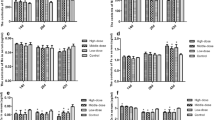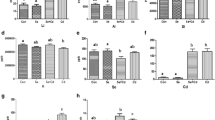Abstract
This study aims to investigate the contents of trace elements in the brain and serum of male chickens and the effect of selenium–chromium(VI) interaction. A chronic experimental model was established by supplementing 22.14 mg/kg K2Cr2O7 with 0.00, 0.31, 0.63, 1.25, 2.50, and 5.00 mg/kg Na2SeO3 mg/kg B.W. to water for chicken daily. After 14, 28, and 42 days of exposure to the solution, the brain and serum of chickens from each group were collected to detect the levels of Ca, Cu, Mn, Fe, Zn, and Mg by inductively coupled plasma mass spectrometer (ICP-MS). Cr(VI) time-dependently accumulated in the brain and serum. The contents of Cr increased both in the brain and serum with prolonged exposure. Cr contents in the brain and serum decreased in all Se groups compared with those in only Cr-treated groups. Ca contents decreased with prolonged exposure and increasing Se dosage. The contents of Cu and Mn increased on the 28th day but decreased on the 42nd day in the brain and serum. Fe and Zn contents decreased in the serum under prolonged exposure and increased on the 28th day but decreased on the 42nd day in the brain. Cr exposure did not significantly affect Mg contents in the brain but slightly decreased those in the serum. Therefore, appropriate doses of Se affected Cr accumulation, leading to adjustments in the contents and correlations of trace elements.






Similar content being viewed by others
Reference
Tagliari KC, Vargas VMF, Zimiani K et al (2004) Oxidative stress damage in the liver of fish and rats receiving an intraperitoneal injection of hexavalent chromium as evaluated by chemiluminescence. Environmental Toxicology & Pharmacology 17:149–157
Chen H, Cao J, Li L et al (2015) Maternal transfer and reproductive effects of Cr (VI) in Japanese medaka (Oryzias latipes) under acute and chronic exposures. Aquat Toxicol 171:178–197
Krumschnabel G, Nawaz M (2004) Acute toxicity of hexavalent chromium in isolated teleost hepatocytes. Aquat Toxicol 70:159–167
Wan H, Zhu Y, Chen P et al (2017) Effect of various selenium doses on chromium (IV)-induced nephrotoxicity in a male chicken model. Chemosphere 174:306
Dashti A, Soodi M, Amani N (2014) Cr (VI) induced oxidative stress and toxicity in cultured cerebellar granule neurons at different stages of development and protective effect of Rosmarinic acid. Environ Toxicol 31:269–277
Von BR, Liu D (2010) Chromium and hexavalent chromium. J Appl Toxicol 13:225–230
Kim J-H, Kang J-C (2016) Oxidative stress, neurotoxicity, and metallothionein (MT) gene expression in juvenile rock fish Sebastes schlegelii under the different levels of dietary chromium (Cr6+) exposure. Ecotoxicol Environ Saf 125:78–84
Cheng J, Fan W, Zhao X et al (2016) Oxidative stress and histological alterations of chicken brain induced by oral administration of chromium (III). Biol Trace Elem Res 173:185–193
Hao P, Zhu Y, Wang S et al. (2016) Selenium administration alleviates toxicity of chromium (VI) in the chicken brain. Biological Trace Element Research:1–9, doi: 10.1007/s12011-12016-10915-12019
Liu Z, Qu Y, Wang J et al (2016) Selenium deficiency attenuates chicken duodenal mucosal immunity via activation of the NF-κb signaling pathway. Biol Trace Elem Res 172:1–9
Peng X, Zhang S, Fang J et al (2014) Protective roles of sodium selenite against aflatoxin B1-induced apoptosis of jejunum in broilers. International Journal of Environmental Research & Public Health 11:13130–13143
Pacitti D, Lawan MM, Feldmann J et al (2016) Impact of selenium supplementation on fish antiviral responses: a whole transcriptomic analysis in rainbow trout (Oncorhynchus mykiss) fed supranutritional levels of Sel-Plex®. BMC Genomics 17:1–26
Zwolak I, Zaporowska H (2012) Selenium interactions and toxicity: a review. Cell Biology & Toxicology 28:31–46
Chernick M, Ware M, Albright E et al (2015) Parental dietary seleno-L-methionine exposure and resultant offspring developmental toxicity. Aquat Toxicol 170:187–198
Jiang XQ, Cao CY, Li ZY et al (2017) Delineating hierarchy of selenotranscriptome expression and their response to selenium status in chicken central nervous system. J Inorg Biochem 169:13
Lu Z, Marks E, Chen J et al (2014) Altered selenium status in Huntington’s disease: neuroprotection by selenite in the N171-82Q mouse model. Neurobiol Dis 71:34–42
El-Boshy ME, Risha EF, Abdelhamid FM et al (2015) Protective effects of selenium against cadmium induced hematological disturbances, immunosuppressive, oxidative stress and hepatorenal damage in rats. J Trace Elem Med Biol 29:104–110
Chen X, Zhu YH, Cheng XY et al (2012) The protection of selenium against cadmium-induced cytotoxicity via the heat shock protein pathway in chicken splenic lymphocytes. Molecules 17:14565–14572
Zhao W, Liu W, Chen X et al (2014) Four endoplasmic reticulum resident selenoproteins may be related to the protection of selenium against cadmium toxicity in chicken lymphocytes. Biol Trace Elem Res 161:328–333
Liu LL, Li CM, Zhang ZW et al (2014) Protective effects of selenium on cadmium-induced brain damage in chickens. Biol Trace Elem Res 158:176–185
Li X, Xing M, Chen M et al (2017) Effects of selenium-lead interaction on the gene expression of inflammatory factors and selenoproteins in chicken neutrophils. Ecotoxicol Environ Saf 139:447–453
Baltaci AK, Arslangil D, Mogulkoc R et al (2017) Effect of resveratrol administration on the element metabolism in the blood and brain tissues of rats subjected to acute swimming exercise. Biol Trace Elem Res 175:421–427
Youssef MA, Elkhodery SA, Ibrahim HM (2013) Effect of selenium and vitamin C on clinical outcomes, trace element status, and antioxidant enzyme activity in horses with acute and chronic lower airway disease. A randomized clinical trial. Biol Trace Elem Res 152:333–342
Torres MA, Barros MP, Campos SC et al (2008) Biochemical biomarkers in algae and marine pollution: a review. Ecotoxicology & Environmental Safety 71:1–15
Ansar S (2016) Effect of selenium on the levels of cytokines and trace elements in toxin-mediated oxidative stress in male rats. Biol Trace Elem Res 169:129–133
Liu Y, Zhao X, Zhang X et al (2016) Effects of oral administration of CrCl3 on the contents of ca, Mg, Mn, Fe, Cu, and Zn in the liver, kidney, and heart of chicken. Biol Trace Elem Res 171:459–467
Liu Y, Pan H, Xiao Z et al. (2016) Effects of excess Cr3+ on trace element contents in the brain and serum in chicken. Biological trace element research:1-7, doi:10.1007/s12011-12016-10875-12010
Caprara GA, Morabito C, Perni S et al (2016) Evidence for altered Ca2+ handling in growth associated protein 43-knockout skeletal muscle. Front Physiol 7:493
Doengi M, Hirnet D, Coulon P et al (2009) GABA uptake-dependent Ca (2+) signaling in developing olfactory bulb astrocytes. Proc Natl Acad Sci U S A 106:17570–17575
Qin L, Raggatt LJ, Partridge NC (2004) Parathyroid hormone: a double-edged sword for bone metabolism. Trends in Endocrinology & Metabolism Tem 15:60–65
Desai V, Kaler SG (2008) Role of copper in human neurological disorders. Am J Clin Nutr 88:855S–858S
Hureau C, Faller P (2009) Aβ-mediated ROS production by cu ions: structural insights, mechanisms and relevance to Alzheimer’s disease. Biochimie 91:1212–1217
Uchida Y (1994) Growth-inhibitory factor, metallothionein-like protein, and neurodegenerative diseases. Biol Signals 3:211–215
Takeda A (2003) Manganese action in brain function. Brain Res Rev 41:79–87
Aguirre JD, Culotta VC (2012) Battles with iron: manganese in oxidative stress protection. J Biol Chem 287:13541–13548
Schwarz C, Ebner KM, Furtner F et al (2017) Influence of high inorganic selenium and manganese diets for fattening pigs on oxidative stability and pork quality parameters. Animal 11:345–353
Garringer HJ, Irimia JM, Li W et al (2016) Effect of systemic iron overload and a chelation therapy in a mouse model of the neurodegenerative disease hereditary ferritinopathy. PLoS One 11:e0161341
Yang M, Cobine PA, Molik S et al (2006) The effects of mitochondrial iron homeostasis on cofactor specificity of superoxide dismutase 2. EMBO J 25:1775–1783
Cass WA, Grondin R, Andersen AH et al (2007) Iron accumulation in the striatum predicts aging-related decline in motor function in rhesus monkeys. Neurobiol Aging 28:258–271
Andersen JK (2004) Iron dysregulation and Parkinson’s disease. Journal of Alzheimers Disease Jad 6:S47–S52
Tyszka-Czochara M, Grzywacz A, Gdula-Argasińska J et al (2014) The role of zinc in the pathogenesis and treatment of central nervous system (CNS) diseases. Implications of zinc homeostasis for proper CNS function. Acta Pol Pharm 71:369–377
Ng E, Lind PM, Lindgren C et al (2015) Genome-wide association study of toxic metals and trace elements reveals novel associations. Hum Mol Genet 24:4739–4745
Olesen RH, Hyde TM, Kleinman JE et al (2016) Obesity and age-related alterations in the gene expression of zinc-transporter proteins in the human brain. Transl Psychiatry 6:e838
Seve M, Chimienti F, Devergnas S et al (2004) In silico identification and expression of SLC30 family genes: an expressed sequence tag data mining strategy for the characterization of zinc transporters’ tissue expression. BMC Genomics 5:1–9
Washabaugh MW, Collins KD (1986) Dihydroorotase from Escherichia coli. Sulfhydryl group-metal ion interactions Journal of Biological Chemistry 261:5920–5929
Tarasov EA, Blinov DV, Zimovina UV et al (2015) Magnesium deficiency and stress: issues of their relationship, diagnostic tests, and approaches to therapy. Ter Arkh 87:114–122
Nuoranne P (1978) On the reliability of the magnesium serum value as an indicator of body magnesium status. Nordisk Veterinaermedicin 30:71–73
Euser AG, Bullinger L, Cipolla MJ (2008) Magnesium sulphate treatment decreases blood–brain barrier permeability during acute hypertension in pregnant rats. Exp Physiol 93:254–261
Marchi N, Tierney W, Alexopoulos AV et al (2011) The etiological role of blood-brain barrier dysfunction in seizure disorders. Cardiovascular Psychiatry and Neurology 2011:482415
Johnson AC, Tremble SM, Chan SL et al (2013) Magnesium sulfate treatment reverses seizure susceptibility and decreases neuroinflammation in a rat model of severe preeclampsia. PLoS One 9:e113670–e113670
Chen P, Zhu Y, Wan H et al. (2017) Effects of the oral administration of K2Cr2O7 and Na2SeO3 on Ca, Mg, Mn, Fe, Cu, and Zn contents in the heart, liver, spleen, and kidney of chickens. Biological trace element research:1-12, doi:10.1007/s12011-12017-10999-x
Almutairi MMA, Gong C, Xu YG et al (2015) Factors controlling permeability of the blood–brain barrier. Cellular & Molecular Life Sciences Cmls 73:1–21
Acknowledgements
This work was supported by the National Key R&D Program (2016YFD0501208, 2016YFD0501007) and the Shandong Modern Agricultural Technology & Industry System (No. SDAIT-11-04).
Author information
Authors and Affiliations
Corresponding authors
Ethics declarations
The animal care and use procedures applied in the study were conducted under the protocols approved by the Institutional Animal Care and Use Committee of Shandong Agricultural University (SDAU 2015-07).
Conflict of Interest
The authors declare that they have no competing interests.
Rights and permissions
About this article
Cite this article
Zhu, Y., Chen, P., Wan, H. et al. Selenium–Chromium(VI) Interaction Regulates the Contents and Correlations of Trace Elements in Chicken Brain and Serum. Biol Trace Elem Res 181, 154–163 (2018). https://doi.org/10.1007/s12011-017-1038-7
Received:
Accepted:
Published:
Issue Date:
DOI: https://doi.org/10.1007/s12011-017-1038-7




